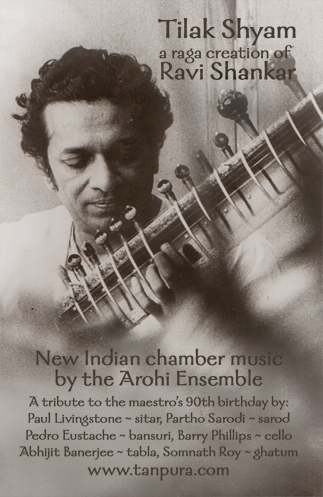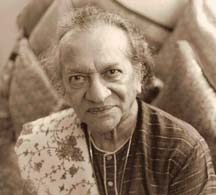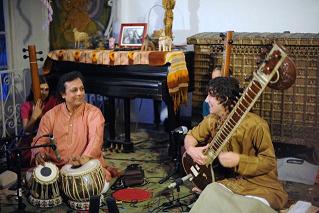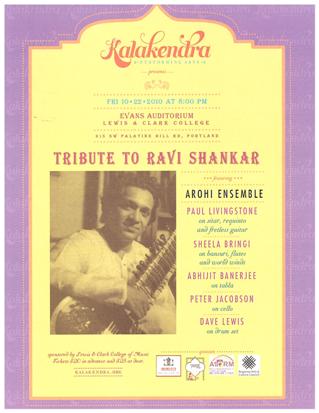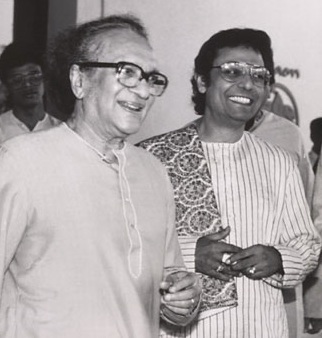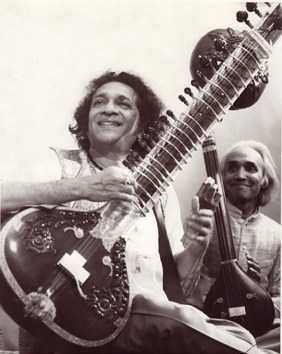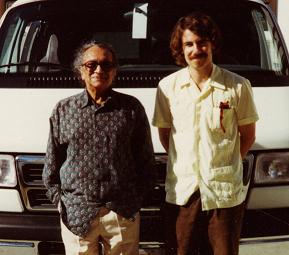In memoriam of our legendary guru,
maestro and visionary Pandit Ravi Shankar
As Gandhi was for us in the high ground of the moral universe and Tagore was in the realms of exquisite poetic imagery and song, Ravi Shankar was for the sublime and effervescent abstraction of music! Panditji's art was a reflection of the world around him, deep and rich, full of wonder, quiet, still and timeless as if communicating from an ancient era long forgotten. Simultaneously, the sound is still so fresh and alive, pulsing, dancing and bubbling over with joyous playful abandon.
An approach sophisticated and complex, yet profoundly simple in its impact on the psyche. With uncompromising adherence to the highest standards of classical raga purity, yet he was highly innovative, always creative and different every time. Expanding the limits of technique and skillfulness at the same time full of emotional soulfulness. A complete music which through it all he exuded love... Love for life. Love for others and Love for God.
Jai guru, we miss you! Our KPFK tribute from December is online here opening with a sound collage of Raviji's music and voice relating the spiritual context of raga music.
Ravi Shankar Tribute, part One (a classical legacy)
A look at some of the lesser known facts and musical achievements
of Ravi's colorful artistic life.
Part One on Raviji's legacy as a classical artist and ambassador
of classical raga music worldwide.
Part Two (upcoming) will focus of Raviji's innovatoions in the field
of east/west crossover and world music.
When I was 12 years old I found a record of
Ravi Shankar, which my parents owned but had never played for me.I had heard
the sitar in the Beatles music so I was intrigued and put Ravi's music onto the
turntable to listen right away.I remember the psychedelic album cover
and each track, though I've since lost the vinyl.Raviji had played Raga Desh, Raga Abhogi and there was a magnificent tabla solo in jhaptal by
the late great Ustad Allah Rakha.
I remember closing my eyes and becoming
completely immersed in the music.Though I had no understanding of what
was happening technically, I had a truly transcendent experience that
day.Listening to this amazing music on big late seventies headphones
with my eyes closed, I had the experience of bathing under a waterfall of
music.Though I had never listened to music with track lengths of 15-25
minutes before, somehow this 'other worldly' music completely captivated this
American kid.
From that moment I was obsessed with wanting to play sitar.It wasn't
until I went to school in India at the age of 15 that I was finally able to
study sitar and tabla from my first teacher Mr. Ajit Singh.Subsequently,I
went to college at Cal Arts majoring in Indian Music under Amiya Dasgupta, a
direct 50-year disciple of Ravi Shankar. Amiyaji sadly passed away in
1996, and I was continuing my studies with a leading sarod disciple of Ustad Ali Akbar Khan, Rajeev Taranath. Rajeevji had come to Los Angeles to
replace Amiya’s position at Cal Arts and it was as that I met Raviji.
I went backstage at Ravi’s 75th birthday concert produced by the Music Circle in Pasadena and managed to introduce
myself in the green room as a long time student of Amiya's.Raviji
immediately looked me in the eyes and told me I was part of their family and
invited me the following week to his home in San Diego to continue my talim (studies) with him.
A touching detail I will never forget is that when I told Ravi, that I had
begun to learn from Rajeev, Raviji unbeknownst to me had the class and respect
to ask Rajeevji (a junior artist to him, who Raviji actually taught himself at
several points in the past) if it would be ok to teach me!?! This was the
beginning of beautiful relationship with guruji and I had the great honor of
accompanying him on several tours and learning whenever he could find time over
the next 15 years.
Aside from all the well-recognized accolades he has received
throughout his life, I want to express my sincere gratitude for Raviji’s
dedication and generosity as a committed and exacting teacher of this living
tradition.For this he has been an
inspiration for me, not only as a performer and composer, but also as a teacher of this music, through
which his presence, dynamism and tenacity have been an example of the highest order.
Ravi, an icon of creative music
and ambassador of Indian culture to the world turns 90 years young on April 7th. Our Los Angeles based ‘Arohi
Ensemble’ is releasing the joyous and exuberant ‘Tilak Shyam’ in celebration of this auspicious birthday.Composed for an east/west Indian
chamber ensemble, the newest Arohi
release features a dynamic collaboration of virtuoso artists from India and
America. This newly recorded work is based off of a raga which guruji created in 1954.
This five-movement suite
follows the traditional sequence of raga development through the stages of alaap (meditation), jor (pulse), madya laya (medium tempo), drut (fast laya)
& jhala (climax). The piece
features new arrangements, orchestration, and improvisations by all six artists;
four of Ravi’s direct disciples, including sarod
player Partho Sarothy, sitarist Paul Livingstone, bansuri player Pedro
Eustache and cellist Barry Phillips, along with two of the leading
percussionists of India, Abhijit Banerjee on tabla and Somnath Roy on ghatum. This new music
‘Tilak Shyam’ is deeply indebted to the maestro and dedicated to the
on going legacy of his musical dialogue between east and west, which he
tirelessly pioneered over the lifetime of his colorful career.
The masetro’s prolific output of creative excellence across
borders, traditions and idioms have earned him perhaps his most appropriate
title, christened by his dear friend, the late George Harrison, as ‘the Godfather
of World Music’. His lifelong
pursuit of international collaboration persistently continued even in the face
of intense criticism from his home country of India.
Raviji’s mark has stood the test of time for a number of
reasons.Apart from all his innovations in music, the sitar itself and a myriad of successful contemporary
explorations, his dedication as a master performer and as a teacher of the
ancient raga forms have always been
at the forefront of his artistic vision. It is openly recognized by Indian
classical musicians across a spectrum of gharanas
(styles) that his ragdar (purity
of raga), is of the highest order.
The fact that he never lost sight of his foundation and
maintained the highest degree of classicism reflects his deep concern for the
longevity and relevance of the music to the younger generation.The extraordinary achievements of his
own daughter Anoushka, (a brilliant artist in her own right) are additional
testament to this commitment.As a friend since her mid teenage years, I will never forget the mental
capacity and flawless photographic musical memory Anoushka demonstrated in our
lessons together as she would spit back complex taans (melodic runs) and intricate tehais (rhythmic cadences), after hearing them just once from
guruji.
Raga Tilak Shyam is one of the many raga creations of the maestro.Much
more than just a composition, the creation of a raga entails the construction of an entire melodic structure with
formal guidelines and phraseologies unique to itself.Once a raga is
established, there are infinite possibilities for creative exploration and
literally thousands of compositions may be realized within its framework.As a composite raga, it utilizes concrete elements from both Raga Tilak Kamod and Raga Shyam Kalyan, two traditional
evening ragas, which when combined, give l ife to an entirely new sonic universe.The nomenclature of Raga Tilak
Shyam references these two traditional ragas.It is through the creative genius of master artists like Panditji, that new
ragas are created.
It is with great humility and honor that we step into these forms which have enlarged
the palette of our music.Through the inspiration of Raviji, we have been
empowered to take fresh approaches in composing and arranging creative new
music, as well as honing the practice of improvisation, which sparks at the
heart of our classical music.I
thank God for an opportunity to do my small part in this ocean of music.
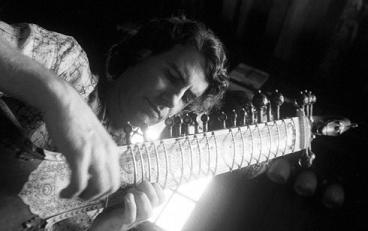 Photo By Jay Matsueda
Photo By Jay Matsueda
(film, television, dance & theater), an active educator, producer & community activist with
diverse experience with classical raga music, jazz, pop & world crossover
to his record. Paul’s own contemporary
music is grounded in the rich aesthetics of Indian music and embraces seemingly
disparate global elements in a commitment to a compelling cross-cultural sound
that reflects his innermost social, political and spiritual values.

